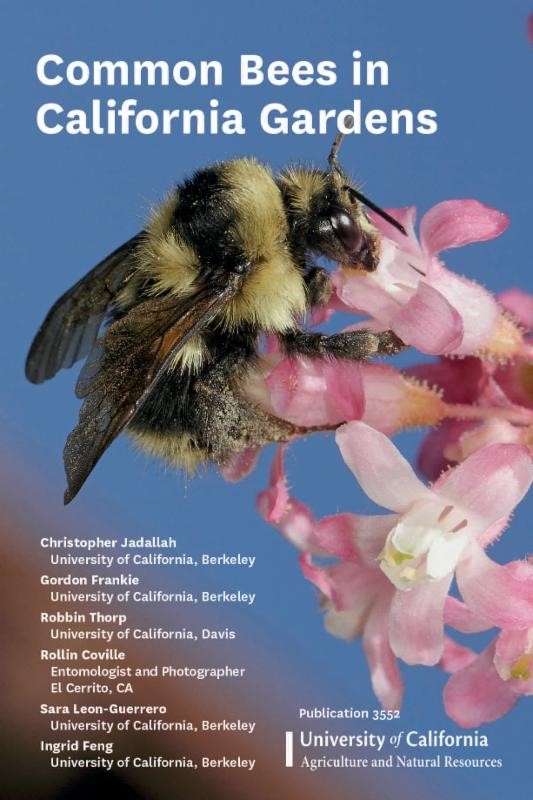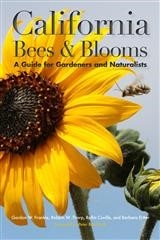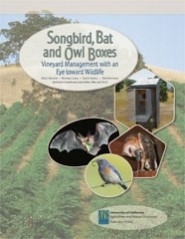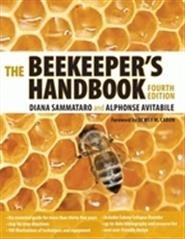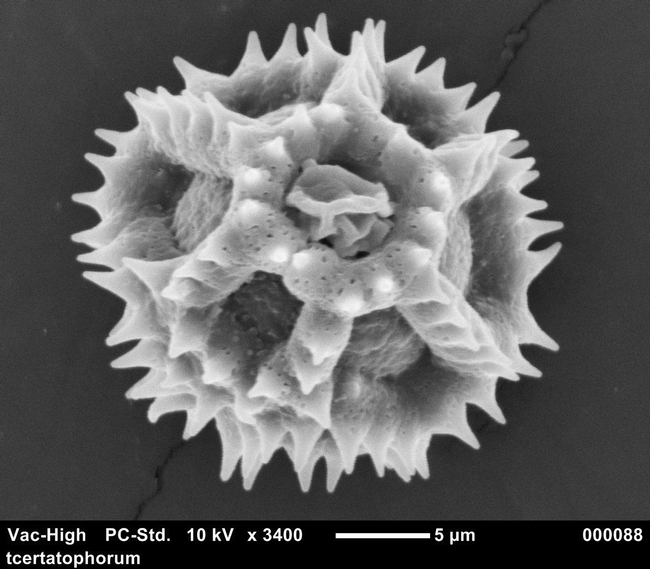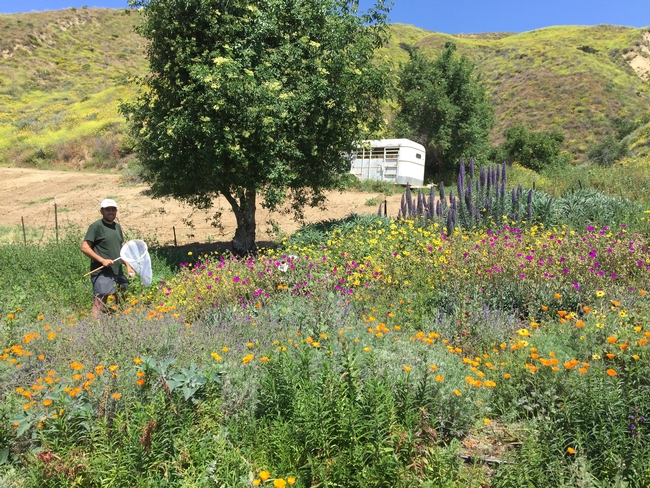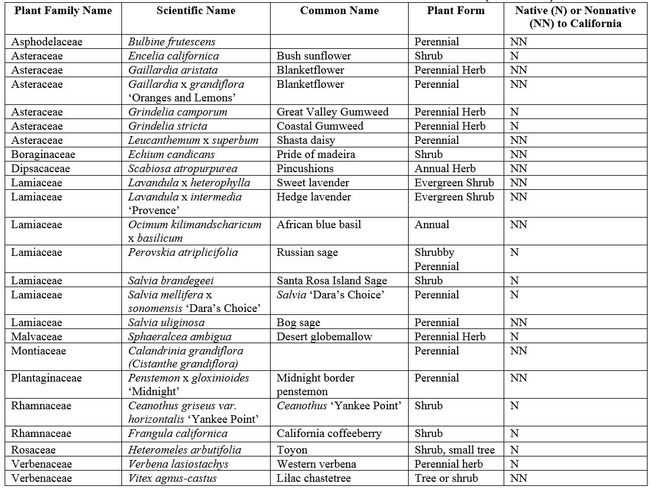
Posts Tagged: pollinators
Bees, Bats, Birds and Blooms - PUBS
UC-ANR PUBLICATIONS has some helpful guides for protecting, identifying and helping pollinators thrive. Check'em out
|
Nearly 1600 species of native bees can be found in California's rich ecosystems; this colorful pocket-sized card set will help you identify 24 of the most common bees found in urban gardens and landscapes. Included for each featured bee are color photographs, a general description of appearance, the distribution and richness, flight season, nesting habits, floral hosts, and how each transports pollen. 3552 $15.00 $11.25- Through June 30 |
|
California is home to over 1600 species of undomesticated bees—most of them native—that populate and pollinate our gardens, fields, and urban green spaces. In this absorbing guidebook, bee and botany experts from UC Berkeley's Urban Bee Lab introduce us to this diverse population, holding a magnifying glass up to the twenty-two most common genera. 3546 $28.00 $18.00--Through June 30 |
|
Bats are important pollinators and you can turn your vineyard, farm, or garden into a wildlife refuge and control pest activity naturally with this handy guide. Although written with vineyard managers in mind, anyone interested in learning about nest boxes will find this guide useful. Includes patterns for building your own boxes and advice on where to place your boxes for best results. 21636 $15.00 $11.25- Through June 30 |
|
This handbook from Cornell University Press provides step-by-step directions accompanied by more than 100 illustrations for setting up an apiary, handling bees, and working throughout the season to maintain a healthy colony of bees and a generous supply of honey. This book explains the various colony care options and techniques, noting advantages and disadvantages, so that beekeepers can make the best choices for their own hives. Reviewed and approved by UC experts for inclusion in our catalog, we're pleased to make this resource available. 3543 $30.00 |
There's more about how to create a haven for bees and other pollinators in these
free downloads:
How to Attract and Maintain Pollinators in Your Garden
About three-quarters of all flowering plants rely on insects or birds for pollination, and that includes one-third of all crop plants. Learn how to create a landscape that is welcoming for bees and many other pollinators.
California Bee-Friendly Garden Recipes
Tips on how to make your garden more bee-friendly, whether you have a cottage garden or vegetable garden, or even a drought-tolerant native plant garden.
Bees in the Neighborhood: Best Practices for Urban Beekeepers
Learn beekeeping basics as they apply to urban environments as well as how to keep your bees good neighbors. Good for bees, good for beekeepers, and good for neighbors.
|
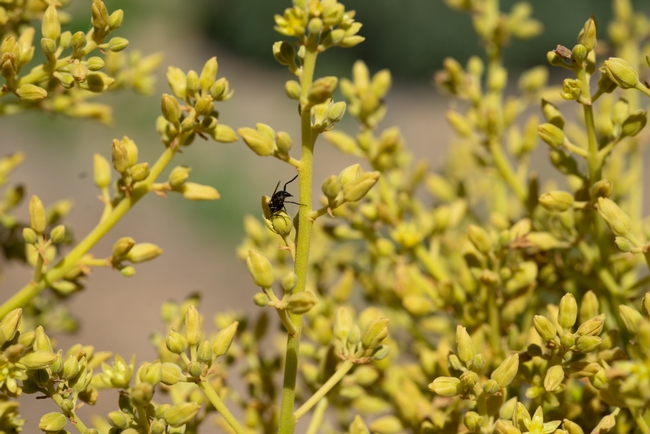
avocado flower and fly 2
Pollen Control
https://news.missouri.edu/2020/bee-thankful-for-the-evolution-of-pollen/
‘Bee' thankful for the evolution of pollen
Missouri U. researchers discover wildflower's spiny pollen
adapts to help plants reproduce
Over 80% of the world's flowering plants must reproduce in order to produce new flowers, according to the U.S. Forest Service. This process involves the transfer of pollen between plants by wind, water or insects called pollinators -- including bumblebees.
In a new study, researchers at the University of Missouri discovered spiny pollen -- from a native wild dandelion species in the southern Rocky Mountains -- has evolved to attach to traveling bumblebees. Using a highly detailed electron scanning microscope, the research team could observe the microscopic surface of the spiny pollen, which otherwise looks like yellow dust to the naked eye.
"The spiny pollen actually acts like Velcro," Lynn said. "So, when bees are harvesting pollen for food, this pollen is sticking to their hair. It's a great example of mutualism where the plant needs the pollinator to reproduce and the pollinator needs the plant for its food."
The researchers plan to study how a bumblebee's hairs contribute to this process.
For more on how clever plants are, check out Michael Pollan's Botany of Desire.
Fireworks in the Garden: Octopus Agave in Bloom
In this weekly blog, Dr. Annemiek Schilder, Director, UCCE Ventura County and Hansen Agricultural Research and Extension Center, shares her observations about the natural world across the seasons. As she says:
"Gently observing your surroundings with curiosity will teach you some amazing things. There are so many fascinating things happening under our noses, only wanting for an observant eye."
The flowering spikes of the octopus agave (Agave vilmoriniana), currently in bloom in the Master Gardener Demonstration Garden at HAREC in Santa Paula, are seriously impressive at more than 12 feet tall. Octopus agave is a drought-tolerant plant native to the Mexican desert where it grows on rocky ground. The gray-green smooth, twisting leaves with flexible spikes at the tips give the plant an octopus-like appearance. Like other agaves, it is monocarpic, flowering only once in its life before it dies.
Agaves belong to the family Asparagaceae and are therefore related to asparagus. Indeed, young flower spikes may resemble giant asparagus spears. Flowering usually occurs between 6 and 25 years of age. The plant invests all of its energy into producing a spectacular flower display as its last hurrah. The copious small yellow flowers start opening at the bottom of the spike, moving upwards in waves. Flowering may occur over a period of 4 to 8 weeks.
Agave flowers are a magnet for pollinating insects and hummingbirds. However, in their native habitat, nectar-feeding bats, such as the lesser long-nosed bat and the Mexican long-tongued bat, play an important role in agave flower pollination. This may also explain the height of the flower spikes. Bats pollinate at night and are critical for seedset. In the absence of these specialized bats, fewer than 5% of the flowers may produce seed. Commercial cultivation of agave for tequila, which involves cutting off flower stalks, as well as pesticides and habitat destruction have been put forward as reasons for the current endangered status of some of these bat species in Mexico.
In addition to seeds, plantlets called “bulbils” may be produced in large numbers on spent flower stalks. These bulbils are exact clones of the mother plant and will root readily when planted in soil. While clonal reproduction is a good short-term strategy for plant survival, it does limit genetic diversity which makes the species less adaptable to environmental changes in the long term.
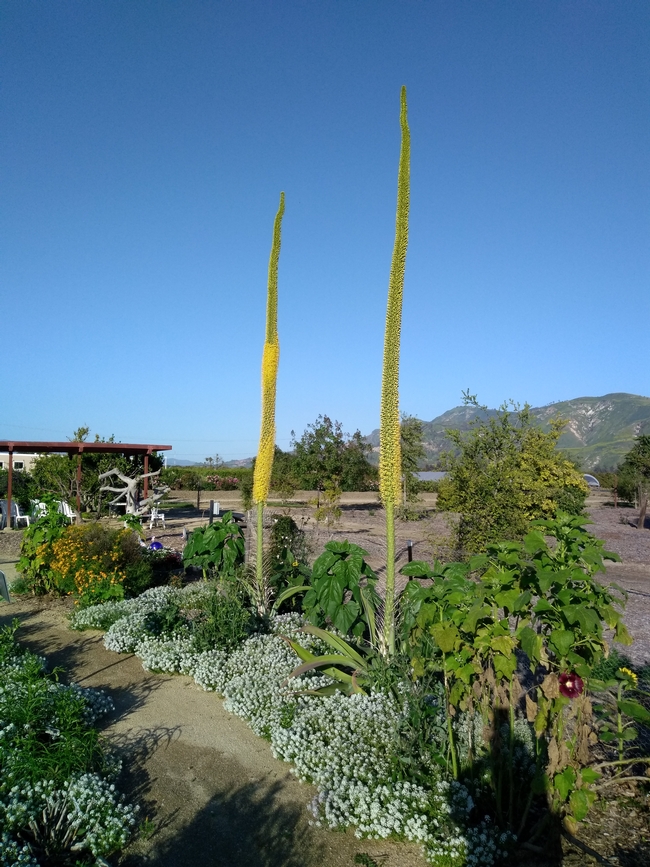
Hedgerows and Pollinators
The Buzz about Hedgerows
Hedgerows are an approved practice under California Department of Agriculture's Healthy Soils Grant Program. That means, growers are eligible to receive grant funding for planting hedgerows. But what exactly are the benefits of hedgerows and why are they worth planting? As a perennial planting it can have immediate impacts on the soil, but what else? The answer lies large in the pollinators and beneficial insects they attract.
The most basic definition of a hedgerow is dense vegetation planted in a linear design. Perennial grasses, shrubs, and even short trees are all candidates for hedgerow plantings, provided they meet the conditions of the local climate and soil. Growers plant hedgerows to achieve one or more of the following desired outcomes:
- To increase habitat for pollinator and beneficial insect populations
- To create a living barrier or fence
- To reduce chemical drift or odor movement
- To intercept airborne particulate matter
- To act as a low windbreak or reduce dust
- To increase carbon storage in biomass and soils
- To provide food, shelter, and shade for aquatic organisms in nearby aquatic habitats
All of these benefits make the case for planting hedgerows on any agricultural operation. In Ventura County, avocado growers stand to see a compelling case for hedgerow plantings with particular attention to pollination services.
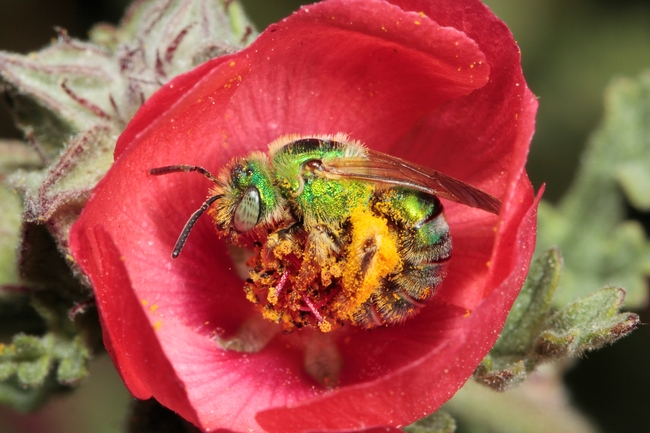
There are many different pollinators who visit avocado flowers, from native bees to flies to honey bees. Some come in the daytime, others visit at night. In the likelihood that honey bees and other pollinators will continue to decline, it is imperative to study the importance of native pollinators on key crops and identify ways to increase habitat for resident populations (NRC 2007; Nordhaus 2011; PHTF 2015; Koh et al. 2016; Sánchez-Bayo and Wyckhuys 2019; DiBartolomeis et al. 2019; Garibaldi et al. 2013). This information not only helps the pollinator populations thrive, but helps avocado growers acquire free increased pollination services for fruitful trees. Several researchers have published accounts of increased pollinator diversity and numbers in hedgerow and field edge planting studies across various agricultural systems (Heller et al. 2019; Long and Anderson 2010; Long et al. 2017; Williams et al. 2015).
In Ventura County, we are seeing some fascinating and relevant research around the impact of hedgerows on pollinators in avocado orchards. A collaborative research project involving Dr. Ben Faber, Avocado Advisor for UC Cooperative Extension Ventura County, and Dr. Gordon Frankie, professor and research entomologist at UC Berkeley and lead investigator of the UC Berkeley Urban Bee Lab, seeks to understand long-term impacts of hedgerows on pollinators of avocado trees. The project, which began in 2014 with three participating avocado ranches, has indicated increased pollinator activity, increased native bee populations, and increased diversity of species with the presence of hedgerow plantings (Frankie, Faber et al. 2020). The results indicate the importance of diversity of pollinator species, not just the honeybee, to avocados. In continuing this research, the team seeks to address the unanswered questions of which pollinators are the most effective at pollinating avocados and which are the most effective at influencing fruit set. A particularly exciting and novel aspect of this project is looking at whether or not there are nocturnal pollinators visiting California avocados. Nocturnal pollinators have been well documented in New Zealand (Pattemore et al, 2018), but none have been yet recorded in California avocados.
Maintaining hedgerows is critical to providing additional habitat for an abundance of pollinators. Creating and maintaining that hedgerow and for which pollinators can be a daunting task to embark on. Luckily for avocado growers, Dr. Frankie and Dr. Faber's team are working with Southern California growers to develop a pollinator garden manual. The manual will provide clear pictures of key pollinators and key plant species that pollinators are drawn to. Detailed imagery, descriptions, and maintenance tips will help make the decision making around planting a hedgerow much easier.
Speaking of selections, there are key plants that are drought-tolerant, easy to maintain, and well-suited for Ventura County's climate. See the table below for some ideas.
Table 1. Main Native Bee Plants Installed in Avocado Orchards 2014-2019
We seek to increase biodiversity, build soil health, and reduce energy use in our agricultural systems to improve our resiliency to climate change impacts, pests, and disease. To keep farming in our families and in our futures. Planting hedgerows is good for the pollinators, which is good for the bottom line and long-term success of the operation.
If you are an avocado grower interested in learning more about the pollinator research project, please contact Dr. Gordon Frankie at the UC Berkeley Urban Bee Lab gwfrankie@berkeley.edu.
Interested in planting hedgerows on your property? You may be able to qualify for a grant through CDFA's Healthy Soils Grant Program to plant hedgerows. Please contact Jamie Whiteford with the Ventura County Resource Conservation District at jamiewhiteford.vcrcd@gmail.comfor more information on how to apply. For those in other areas, Technical Assistance providers are able to discuss the values of hedgerows and funding opportunities for installing them in other agricultural situations: http://ciwr.ucanr.edu/Programs/ClimateSmartAg/TechnicalAssistanceProviders/
Bombus vosnesenskii photo by Rollin Coville
References Cited
DiBartolomeis, M., S. Kegley, P. Mineau, R. Radford, and K. Klein. 2019. An assessment of acute insecticide toxicity loading (AITL) of chemical pesticides used on agricultural land in the United States. PLoS ONE 14(8): e0220029. https://doi.org/10.1371/journal.pone.0220029.
Frankie, G., B. Faber, J. Pawelek, R. Thorp, R. Coville, C. Jadallah, E. Takele, S. I. Rios, T. Bean. 2020. Native Pollinators of California Avocado as Affected by Introduced Pollinator Gardens. International Society of Horticultural Sciences Congress. Acta Horticulturae.
Garibaldi, L.A., I. Steffan-Dewenter, R. Winfree, and 47 other authors. 2013. Wild pollinators enhance fruit set of crops regardless of honey bee abundance. Science 339:1608-1611.
Heller, S., N. K. Joshi, T. Leslie, E. G. Rajotte and D. J. Biddinger. 2019. Diversified Floral Resource Plantings Support Bee Communities after Apple Bloom in Commercial Orchards. Scientific Reports 9 Article number: 17232.
Koh, I., Lonsdorf, E. V., Williams, N. M., Brittain, C., Isaacs, R., Gibbs, J., Ricketts, T. H. 2016. Modeling the status, trends, and impacts of wild bee abundance in the United States. Proceedings of the National Academy of Sciences 113:140–145.
Long, R. F. and J. Anderson. 2010. Establishing Hedgerows on Farms in California. UC ANR Pub 8390, Oakland, CA. http://anrcatalog.ucanr.edu/Details.aspx?itemNo=8390
Long, R., K. Garbach and L. Morandin. 2017. Hedgerow benefits align with food production and sustainability goals. California Agriculture 71:117-119. 10.3733/ca.2017a0020.
NRC. 2007. Status of Pollinators in North America. National Research Council of the National Academies. National Academies Press, Washington, D.C.. 307 p.
Nordhaus, H. 2011. The Beekeeper's Lament. Harper Perennial, NY. 269p.
Pattemore, D., M. N. Buxton, B. T. Cutting, H. McBrydie, M. Goodwin, A. Dag. 2018. Low overnight temperatures associated with a delay in ‘Hass' avocado (Persea americana) female flower opening leading to nocturnal flowering. Journal of Pollination Ecology 23(14): 127-135.
PHTF: Pollinator Health Task Force. 2015. Pollinator Research Action Plan. The White House.
Sánchez-Bayo, F. and K. A. G. Wyckhuys. 2019. Worldwide decline of the entomofauna: A review of its drivers. Biological Conservation 232:8-27.
Williams, N. M., K. L. Ward, N. Pope, R. Isaacs, J. Wilson, E. A. May, J. Ellis, J. Daniels, A. Pence, K. Ullmann, and J. Peters. 2015. Native wildflower plantings support wild bee abundance and diversity in agricultural landscapes across the United States. Ecological Applications 25: 2119–2131
Brush Up On Bees
If you're sticking close to home these days and looking for something to do (or looking for something for kids to do) the Xerces Society has several bee monitoring guides and tools worth checking out.
Developed for conservationists, farmers, land managers, restoration professionals, and community scientists, the Bee Monitoring Protocol and Community Science Guides are useful for documenting how native bee communities change through time in pollinator habitats. The publications include an introduction to bee identification, a detailed monitoring protocol, and data sheets for different habitat types.
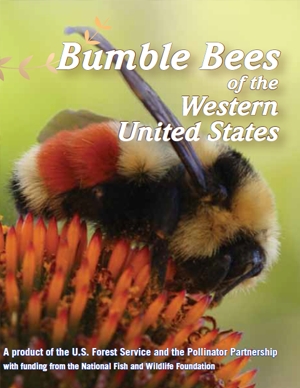
bumble bee xerxes

